A year after SC OK of Meralco power rate hike, complaints, accusations persist
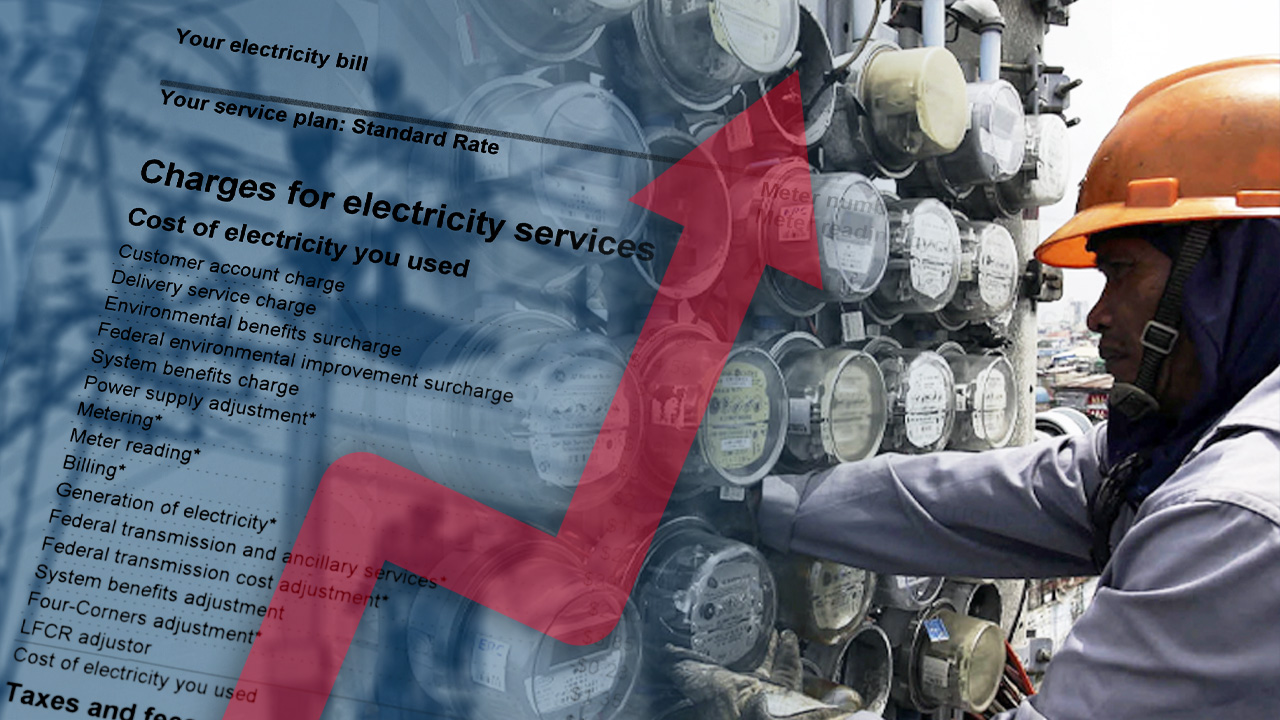
INQ FILE PHOTO
MANILA, Philippines— Over a year after lawmakers and progressive groups slammed the Supreme Court (SC) decision that allowed Manila Electric Company’s (Meralco) power rate hike in 2013, the distributor faces yet another series of accusations amid rising power rates.
In a privilege speech delivered last Nov. 7, Santa Rosa City Rep. Dan Fernandez made several allegations against Meralco, including:
- Refusing to recompute its weighted average cost of capital, which he claimed was too high and passed on to its customers.
- Maintaining a monopolistic franchise that controls 70 percent of the electricity in Luzon.
- Exercising anti-competitive behavior.
READ: Meralco’s capital cost too high, passed on to customers – House rep
Several other lawmakers echoed Fernandez and called for a review of Meralco’s franchise amid increasing electricity rates. Consumer advocates also stressed that power rates should be on a downward trajectory.
While Meralco denied what it described as “baseless” accusations thrown against the utility, Fernandez’s criticism of the power distributor — despite being called out for some factual errors in his speech — has reignited a previous controversy and other issues connected to Meralco, which, as data shows, may continue to persist up to this day.
What went before
In 2013, Bayan Muna and the National Association of Electricity Consumers (Nasecore) challenged the power rate hike approved by the Energy Regulatory Commission (ERC), citing lack of due process and ERC’s grave abuse of discretion.
A significant increase in power rates in Metro Manila and nearby provinces was noted in December 2013, with an additional P800 per kWh bill, representing a 61 percent increase from the November 2013 average.
The hike, amounting to P22.64 billion, was not for additional electricity usage but for costs which Meralco said it incurred for purchasing more expensive electricity from the Wholesale Electricity Spot Market (WESM).
The projected generation cost for November 2013 was expected to rise to P7.86 per kWh.
To mitigate this increase, Meralco proposed to ERC a generation charge of P7.90 per kWh in December 2013 instead of the actual P9.1070 per kWh.
This proposal meant deferring collection of P3 billion of the total P22.64 billion generation cost to February 2014 billing. The ERC approved Meralco’s staggered charge scheme on December 9, 2013, but denied the request to charge carrying costs.
On April 22, 2014, the Supreme Court issued an indefinite temporary restraining order (TRO) against the rate hike. Oral arguments were conducted on January 21, February 4, and February 11, 2014.
Speedy approval
Voting 6-5, the high court last year ruled that there was no grave abuse of discretion on the part of ERC when it approved a gradual increase of P7.67 per kilowatt hour (kWh) for the December 2013 billing and ordered an additional P1.00/kWh increase in the February 2014 billing.
The SC also dismissed the separate petitions filed by Bayan Muna and the National Association of Electricity Consumers for Reforms (Nasecore), arguing that there was a lack of due process when ERC gave its approval.
Still, Bayan Muna appealed to the SC to reconsider its decision, saying that the high court should have a second look at the case.
Former Bayan Muna representative Carlos Isagani Zarate argued that while the SC said there was no abuse on the part of ERC, they maintained that the approval was done in haste.
READ: Bayan Muna appeals SC ruling allowing Meralco to recover P22.64B through power rate hikes
On Dec. 5, 2013, Meralco wrote the ERC asking for authority to stagger the generation cost for the supply month of November 13. The ERC approved Meralco’s request after only one working day.
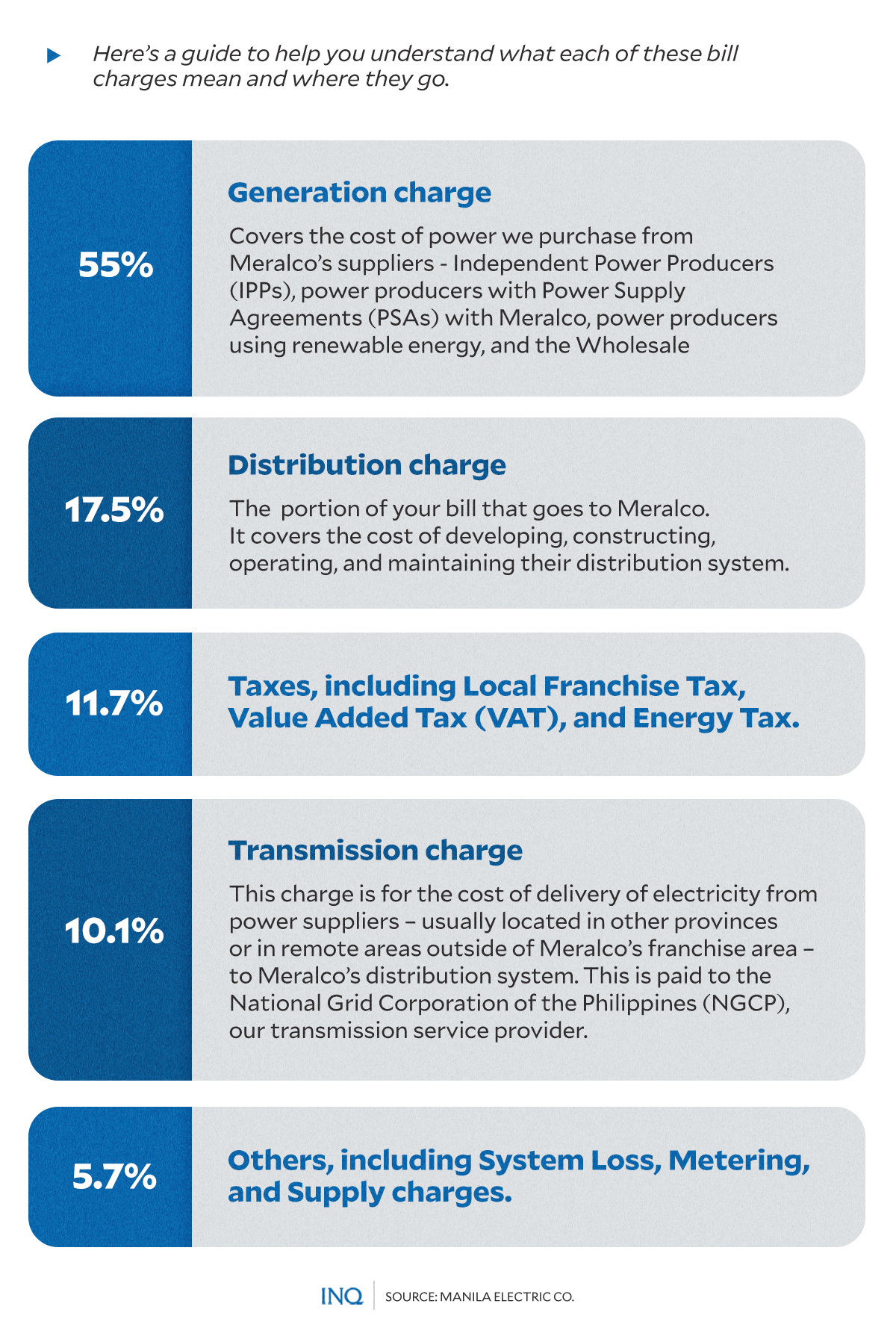
Citing the opinion of Associate Justice Amy Lazaro-Javier — who voted no on the collection of generation costs — Bayan Muna said, “the circumstances should have forced the ERC to conduct a robust investigation on the matter instead of hastily acting in favor of Meralco’s letter.”
Meanwhile, the Advocates of Science and Technology for the People (AGHAM) expressed its dismay over the decision, saying consumers are being abused by Meralco and the generation companies enabled by the law privatizing the power industry.
“With the Supreme Court decision upholding Meralco’s claim of ₱22.64 billion from the consumers, the government continues to protect not the consumers, but the energy private companies from their abuses,” said Jona Yang, AGHAM Secretary General.
High capital costs
While the previous rate hike was attributed to the purchase of more expensive fuel for power generation, lawmakers currently attribute the ongoing increase in rate hike to weighted average cost of capital (WACC) that is too high — which is then passed on to customers.
The WACC is a percentage that determines how much return a company should be getting to ensure the viability of its investments. A higher WACC means a company needs to make more profit to ensure operations, while a lower WACC indicates that it needs only lower profit to keep running.
In terms of its impact on consumers, a high WACC indicates that consumers may experience higher costs for the company’s products or services. On the other hand, a low WACC means consumers may benefit from more stable or lower prices for the company’s products or services.
Meralco spokesperson Joe Zaladarriaga, however, clarified that the power distributor “has no power to determine the weighted average cost of capital (WACC)” as it is a function of the ERC.
Meralco explained that the last approved WACC, 14.97 percent set in 2010, was the lowest given by the regulator, which it said applied to all private distribution utilities and not only Meralco.
It added that it had not had “a determined WACC since July 2015 because there was no completed rate reset during that regulatory period up until now.”
READ: Meralco exec calls ‘overcharging’ accusation ‘baseless’
Increasing rates
Data from Meralco showed that from 2020 to 2022, the average retail electricity rate increased by 13 percent for residential customers — from P9.2357 per kWh to P10.3991 per kWh.
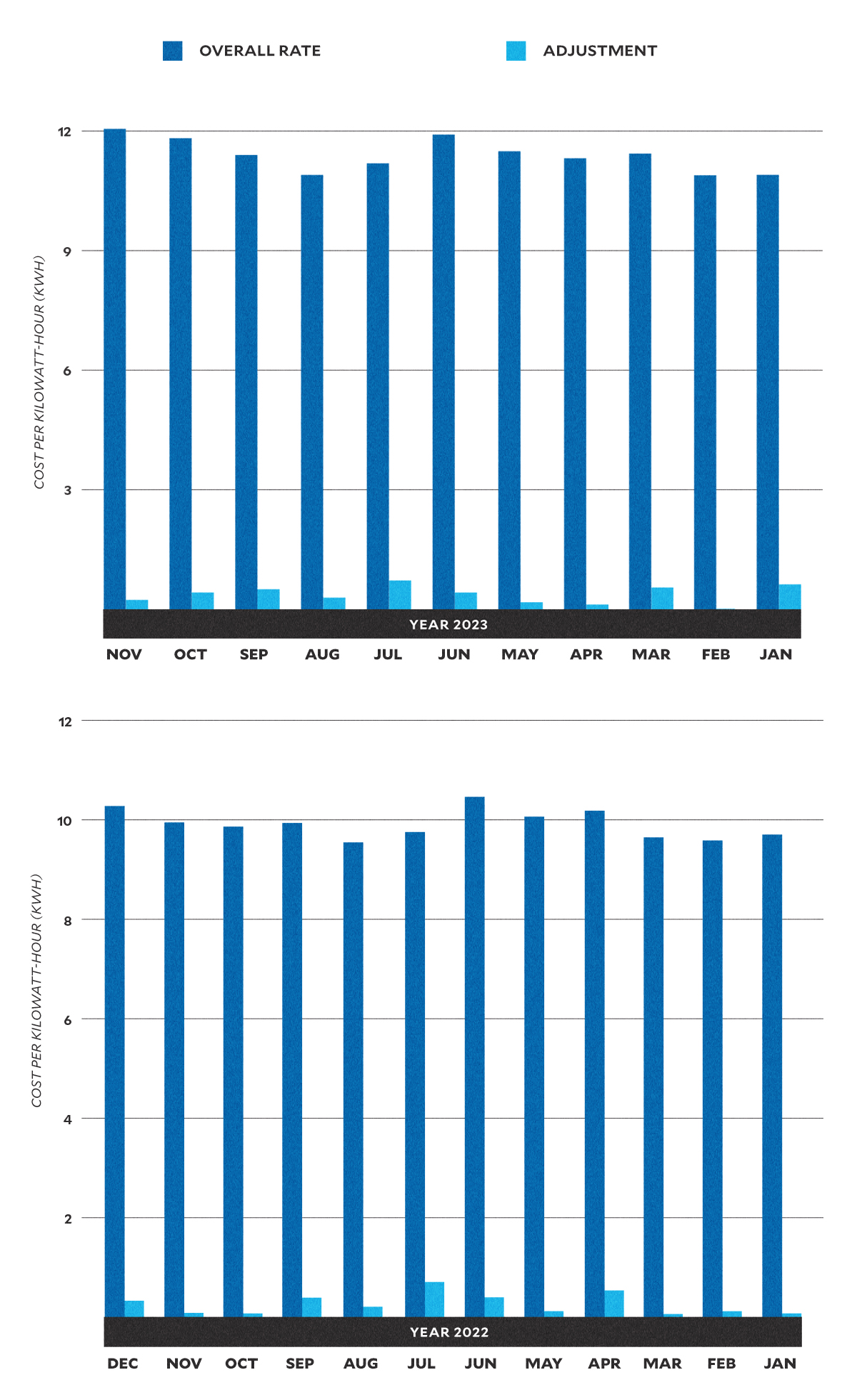
According to Meralco, the increased rates in 2022 were due to higher generation and transmission charges with the spike in demand for power caused by the reopening of the country’s economy in 2021 following the COVID-19 pandemic.
It added that the war in Ukraine aggravated the situation leading to the unprecedented spike in fuel prices, which also caused the higher prices in WESM.
In April last year, the overall rate for a typical household went up by P0.5363 to P10.1830 per kWh compared to the previous month’s rate of P9.6467 per kWh. It was equivalent to an increase of around P107 in the total bill of a residential customer consuming 200 kWh.
The power distributor attributed the rate hike to higher charges from Independent Power Producers (IPP) and the WESM.
Data also showed that the overall rate for residential customers continued to increase since 2022, despite Meralco implementing lower rates in February, April, August, and most notably in July, which saw a decrease of around P144 in the total electricity bill of residential customers consuming 200 kWh.
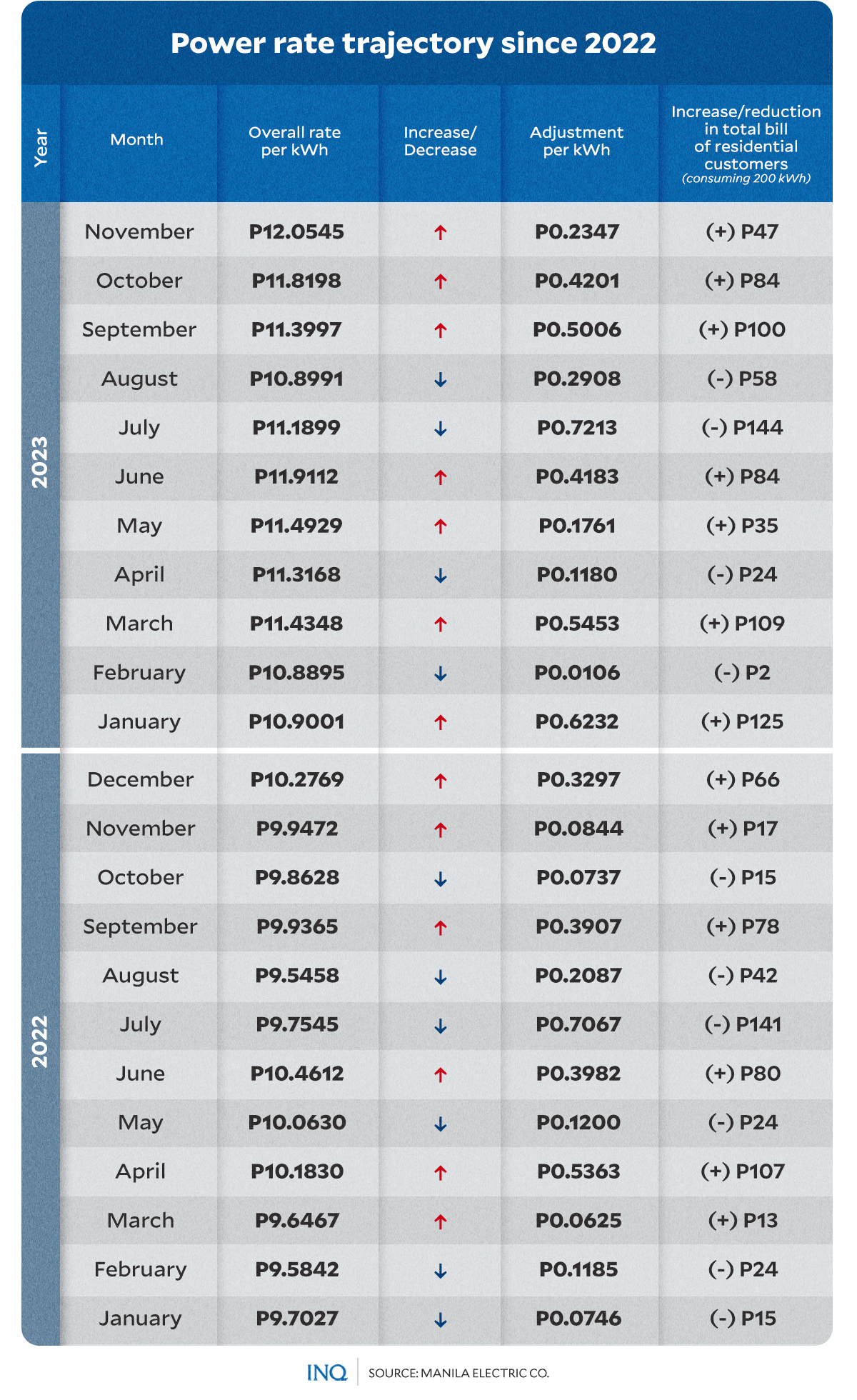
GRAPHIC Ed Lustan
From P10.9001 per kWh in January this year, the overall rate for a typical household shot up to P12.0545 per kWh as of November.
Consumer advocate Romeo “Butch” Junia stressed that power rates in the franchise area being serviced by Meralco should be on a downward trend “as the law granting the utility the franchise to supply electricity mandated that it do so ‘at the least cost’.”
READ: Consumer advocate says power rates should be on downward trajectory
“But instead of the rates normalizing, or declining, they have taken an upward trajectory that would show the mandate for ‘least cost’ isn’t being followed,” said Junia, who had been involved as an intervenor in cases filed at the ERC related to power rates.
“In fact, in many ERC decisions when cost or rate is covered, ERC seems inclined to push rates up as an incentive to utility. My position is the franchise by itself is an incentive, and it should motivate the utility to keep within the least cost. Unfortunately, ERC does not seem to take that view. I wonder,” he added.
Customers get ‘zero’ benefit
Meralco attributed the upward adjustments of the overall rate for residential customers these past months to increases in transmission charges, as well as upticks in generation charges and other charges on specific months.
However, Junia argued that the increasing electricity rates were due to the power distributor’s failure to factor in consumer welfare in its practice of “economies of scale,” or the principle in business that would lower costs as its consumer base grows.
“Usually in economies of scale, as we understand it, the larger you grow, the lower is your cost, so how come the gargantuan franchise of Meralco has not been able to benefit us,” said Junia.
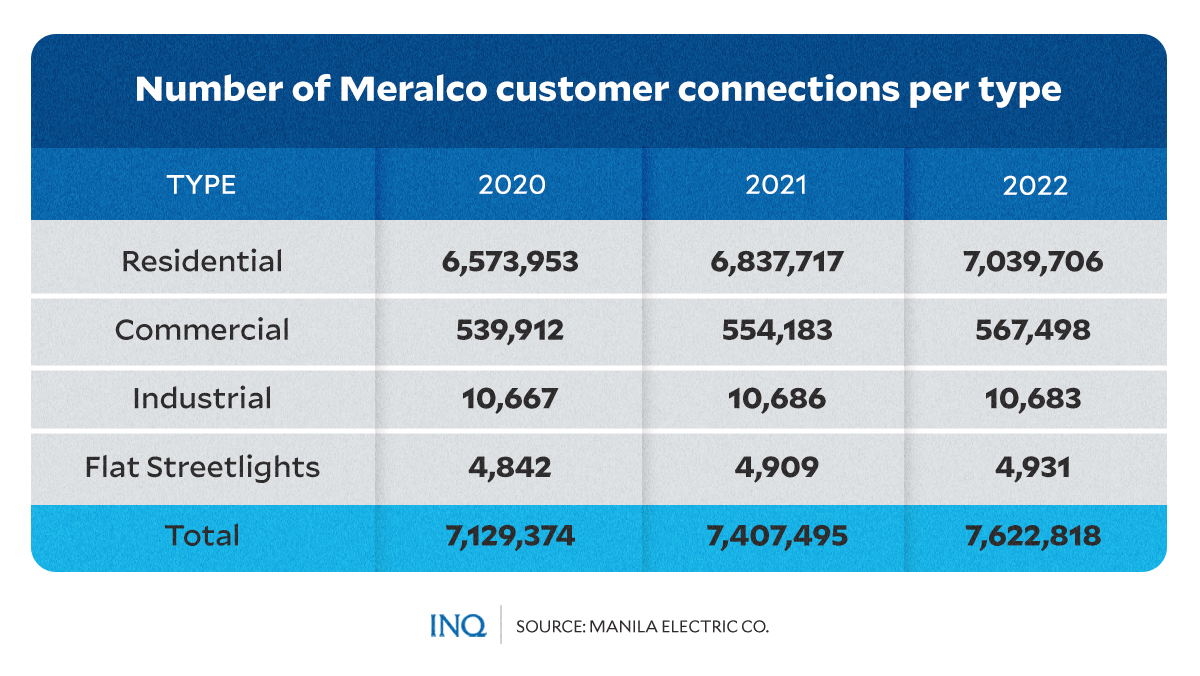
“Instead of inverse proportion where the bigger the size, the lower the cost, it became the opposite where an increase in rates followed an increase in business,” he added.
The continuous rate increases, Junia explained, contradict the expected trend of decreasing costs as a company’s customer base expands.
Meralco is the largest private-sector electric distribution utility in the country, covering 39 cities and 72 municipalities. While its franchise area of over 9,685 km2 corresponds to only 3 percent of the total land area in the country, it accounts for 55 percent of the Philippines’ electricity output.
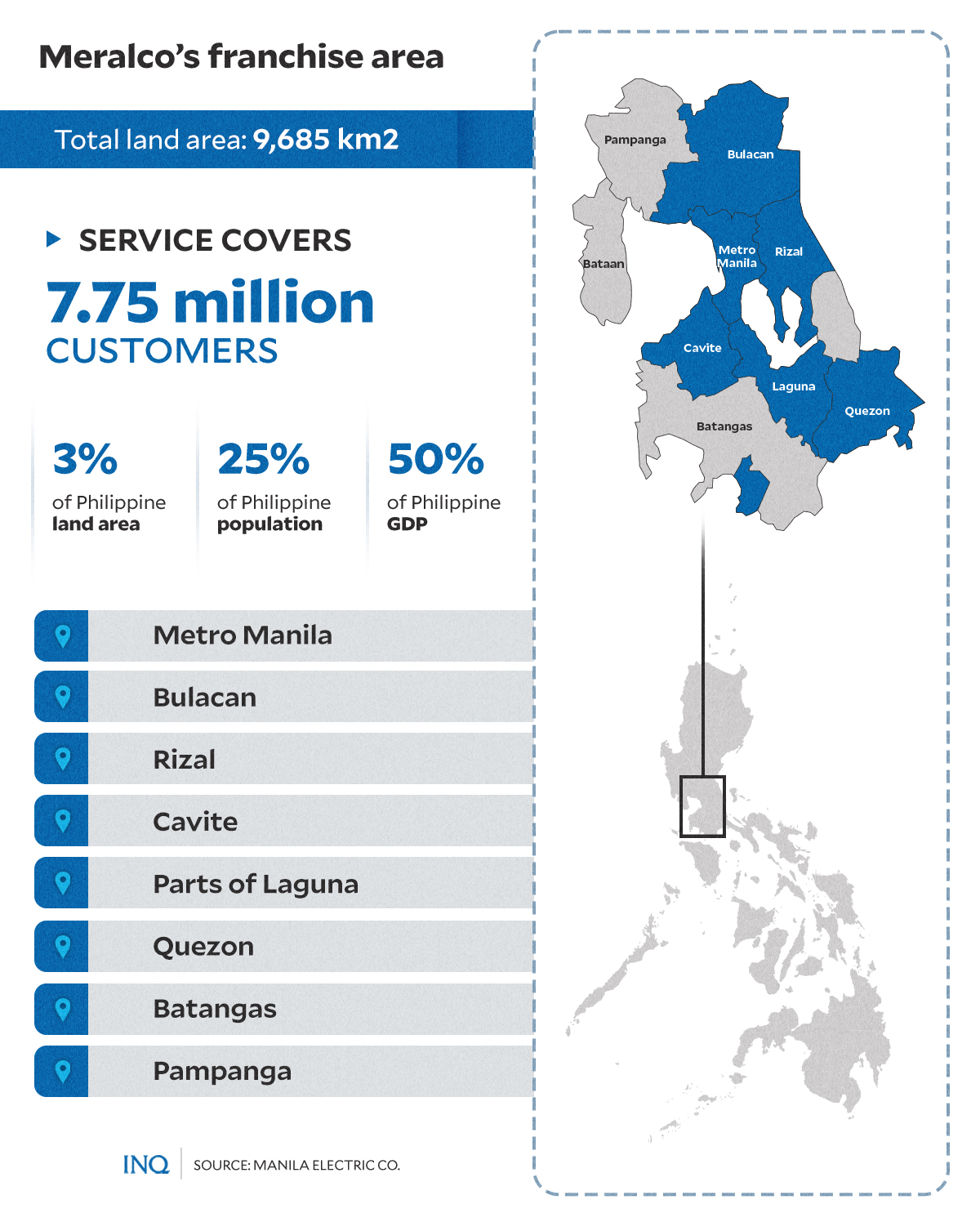
From 2020, Meralco’s customer connections increased by at least 9 percent — from 7.13 million to around 7.75 million this year. Last year, Meralco’s residential customers reached 7,039,706.
Junia noted the disparity between Meralco’s significant growth in the National Capital Region (NCR) and the lack of a corresponding decrease in prices. Citing the rise in rates from PHP0.79 per KWH under the Return on Rate Base (RORB) to PHP1.35 per KWH currently, he argued that Meralco is operating at an uneconomically large scale.
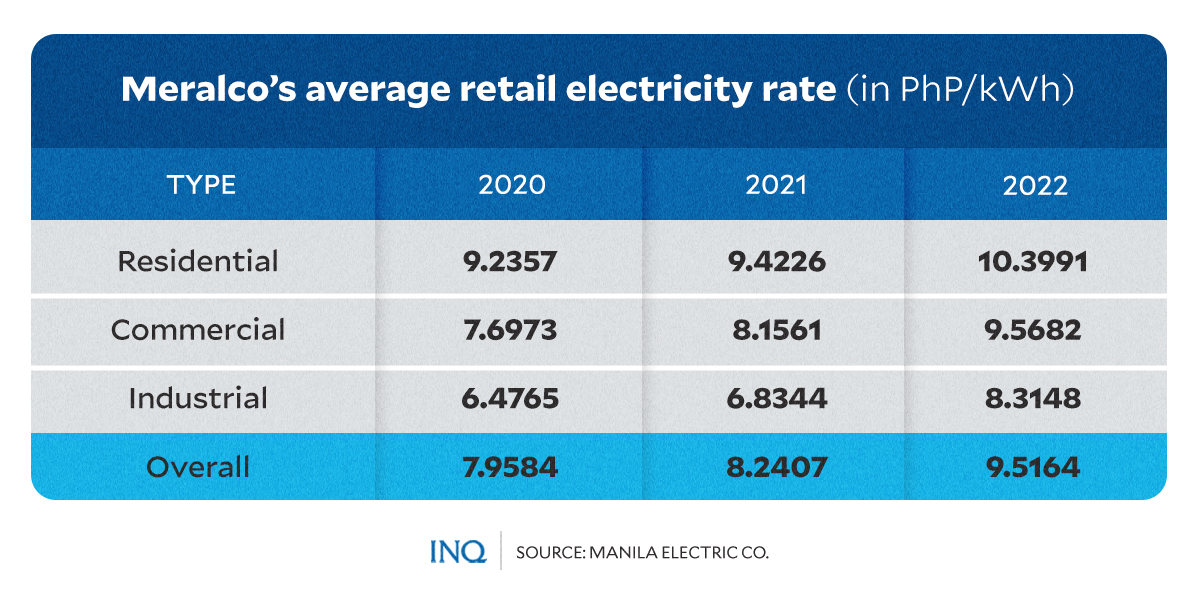
He also highlighted the sharp increase in Meralco’s net earnings, from PHP2.7 billion to over PHP20 billion, indicating a successful business scale-up but not in favor of consumer costs.
Current mix, high generating costs
In a report, Greenpeace and the Center for Renewable Energy and Technology (CREST) highlighted the benefits of decarbonizing and shifting to renewable energy (RE), such as having lower generation costs by the year 2030.
“The report shows how Meralco stands to benefit from shifting to RE, as it would drive down their generation costs by 17.58 percent,” said CREST president Rei Panaligan.
The decrease in generation costs caused by shifting to RE would benefit both Meralco and its consumers.
“Decarbonizing Meralco is a win-win solution for both the company and its shareholders as well as electricity consumers as it will lower costs, increase potential profit, and address the climate emergency and related harms coal and fossil fuel use inflict on communities,” Greenpeace said.
READ: Breaking our backs: SC OKs added Meralco rates for ‘dirty’ power sources
However, the report stressed Meralco’s continued dependence on fossil fuels or “dirty power sources,” especially coal.
Data from Meralco showed that in 2022, over half, or 53.84 percent, of its power distribution utility fuel mix was from natural gas. About 30.90 percent was meanwhile sourced from coal purchases.
Fossil fuels likewise made up most of the 2022 power mix of Meralco PowerGen Corporation (MGen), a wholly owned subsidiary of Meralco — coal (56.18 percent) and natural gas (42.13 percent).
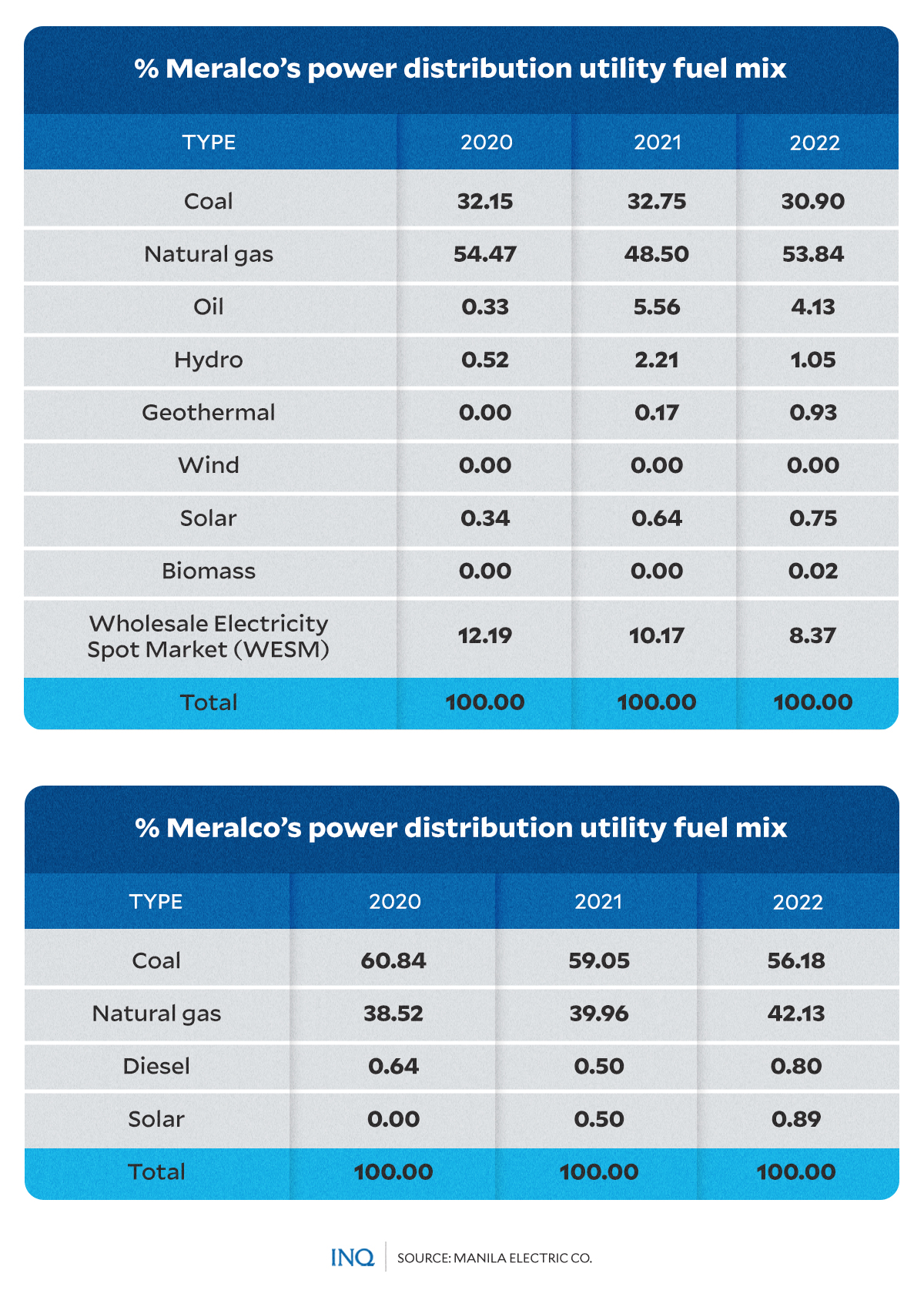
According to MGen president and chief executive officer Jaime Azurin, the parent company aims to reduce direct emissions by 20 percent by 2030 and become coal-free before 2050.
“We will continue to work with the energy industry, government, and other pertinent stakeholders to help further accelerate the country’s energy transition as we aggressively pursue more renewable energy projects. This is in line with Meralco’s long-term sustainability strategy to embark on a just, affordable, and orderly transition to clean energy,” Azurin said.
Through MGen Renewable Energy, Inc., or MGREEN, a subsidiary of MGen, Meralco also seeks to expand its ventures into renewable energy and buildup to establish 1000 MW of renewable energy capacity for the next 5-7 years.
However, Greenpeace argued that while Meralco has laid out plans to diversify its energy portfolio by venturing into renewable energy and energy storage, it continues to build more coal-fired power plants.
The group said it seems to be “an indication that the company does not see any urgency in investing more aggressively in renewables as a way of helping keep the country’s commitments under the Paris Agreement.”
Questions on transparency
Aside from denying accusations such as Meralco’s supposed refusal to recompute its WACC and maintaining a monopolistic franchise, Zaldarriaga likewise said there has been no abuse of market power.
“Records likewise show that Meralco is fully compliant with all government regulations and even outperformed the level of service required by the regulator. This is precisely the reason why some local government units are clamoring for Meralco to take over their service,” Zaldarriaga said.
“Further, while Meralco is the largest utility in the country, it has never committed and has no record of any anti-competitive behavior or abuse of market power,” he went on.
“On the contrary, we have always managed to supply electricity to our customers in the most transparent and least cost manner, and is the only distribution utility that has complied with an ERC directive to refund distribution charges by refunding more than 48 billion pesos in 2023,” he added.
However, Junia belied Meralco’s claim of being always transparent, saying that it has, in all cases, “thwarted all motions for production of documents, on one pretext or another.”
He also noted that the ERC has consistently ruled in favor of Meralco.
“If that is transparency, I don’t know what opaque is. If that is fair regulation for consumers, I don’t know what unfair is,” said Junia.
“I hope the new ERC under the present chair vigorously pursues the principles laid down in the latest NGCP ruling, where costs for 2015 to 2022 to be recoverable must pass the criteria of recovery (prudent, reasonable, necessary, recurring and redounding to consumer benefit) based on actual and historical costs as verified and validated,” he added.
Cross-ownership limitation
Another concern previously pointed out by lawmakers questioning Meralco’s compliance with existing government regulations was the power distributor’s alleged way around the cross-ownership limitation of private power firms, as stated in Section 45 of the Republic Act (RA) No. 9136 or the Electric Power Industry Reform Act of 2001 (EPIRA).
Section 45(b) of EPIRA states that power sectors are allowed cross-ownership. It also states:
“For the purpose of preventing market power abuse between associated firms engaged in generation and distribution, no distribution utility shall be allowed to source from bilateral power supply contracts more than fifty percent (50%) of its total demand from an associated firm engaged in generation but such limitation, however, shall not prejudice contracts entered into prior to the effectivity of this Act.”
However, according to a measure filed last year by representatives of the SAGIP party-list, Meralco was allowed to “circumvent the already generous cross-ownership limitation in the EPIRA.”

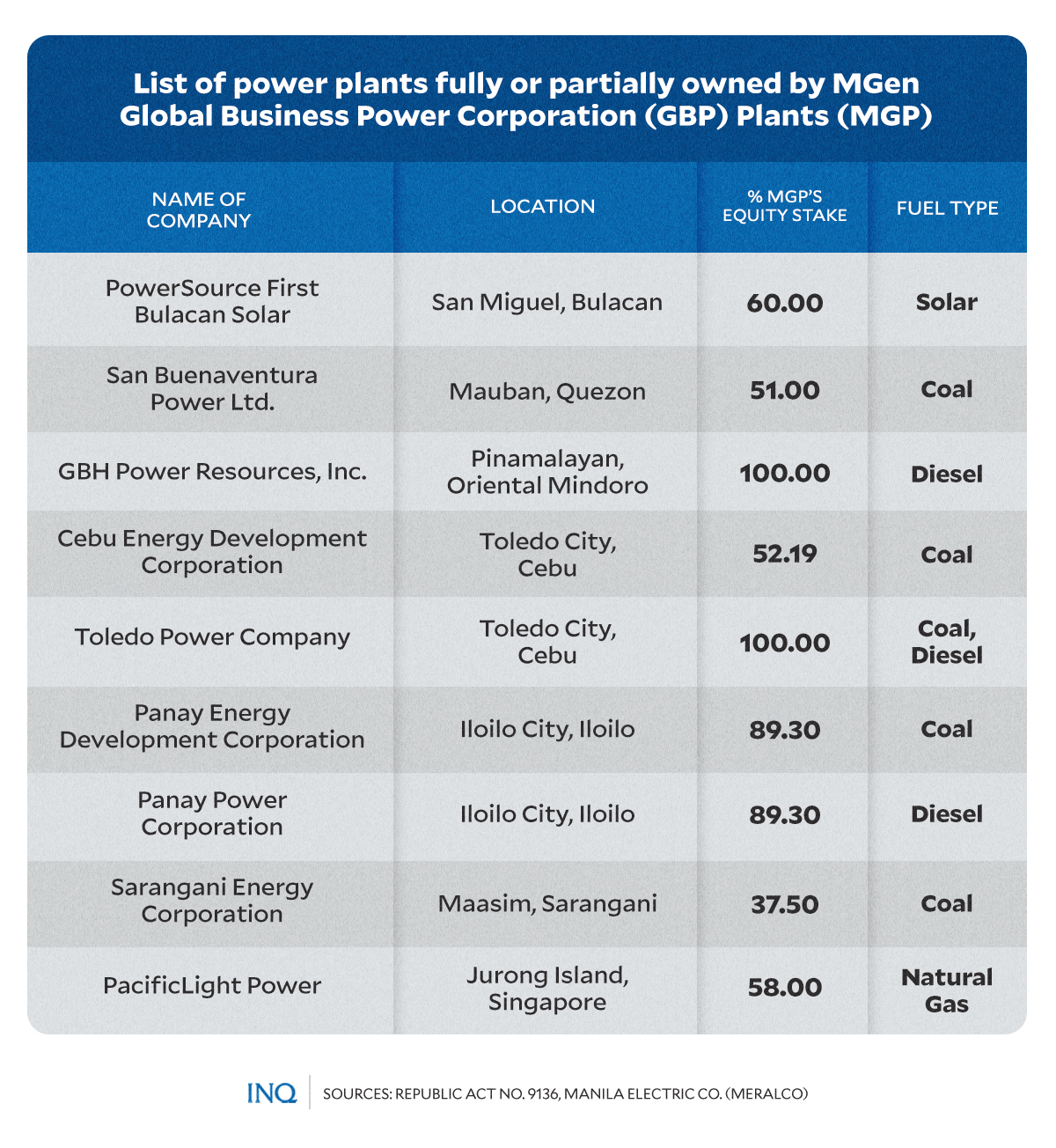
House Bill (HB) No. 174, authored by Representatives Caroline Tanchay and Rodante Marcoleta, aimed to amend the EPIRA law. They argued that:
“Section 4(b), Rule 11 of the Implementing Rules and Regulation of the EPIRA unduly expanded the concept of the limits on the concentration of ownership by redefining ‘control’ as the ‘entity controlling the terms and conditions of the prices or quantities of the output of such capacity sold in the market’ instead of’ ‘the power to direct or cause the direction of the management policies of a person by contract, agency or otherwise’ in Section 45 of the EPIRA.”
“For instance, the Manila Electric Company (Meralco) is known to be the biggest
distributor of electricity in Luzon. Meralco, through its Powergen Corporation (MGEN) can
easily be categorized as an energy cartel,” they said, adding that the power distributor has ownership in the following:
- 51% of the 455MW San Buenaventura Power Plant expansion in Mauban, Quezon
- 100% of the Global Business Power Corporation (GBP), GBP in turn, owns 50% interest in Alsons Thermal Energy Corp. (ATEC)
- ATEC, in turn, holds 75% interest in Sarangani Energy Corporation’s 237MW coal-fired power plant in Sarangani and a 120MW coal-fired power plant in Zamboanga.
In 2017, electric consumers with civil society groups bared that based on Meralco’s 2016 Annual Report, its power supply agreement (PSA) partners are actually their subsidiaries, associates and/or joint venture partners.
READ: Consumers, civil society groups rap Meralco on ‘sweetheart’ deals
“This is nothing but a clear connivance between Meralco and the said generation companies—a deal made out of mutual benefits and equal exchange of favors, just like how ‘sweethearts’ do,” said Erwin Puhawan of the Freedom from Debt Coalition (FDC).
“If the PSAs would push through, Meralco would have freedom to exercise influence over the cost of both the generation and the distribution of electricity,” he added.
‘Practice energy efficiently’
Amid the ongoing discussions caused by the continuous increase in power rates, Meralco urged the public to practice energy efficiency to better manage their electricity consumption.
“Some energy saving tips that customers can practice include unplugging appliances when not in use, regular cleaning of air conditioner filters to optimize its use and using LED bulbs for cost-saving lighting,” Meralco said.
“Meralco customers can also have better control of their monthly electricity bills with the help of the Meralco Mobile App Appliance Calculator that provides information on the energy consumption of appliances and gadgets,” it added.